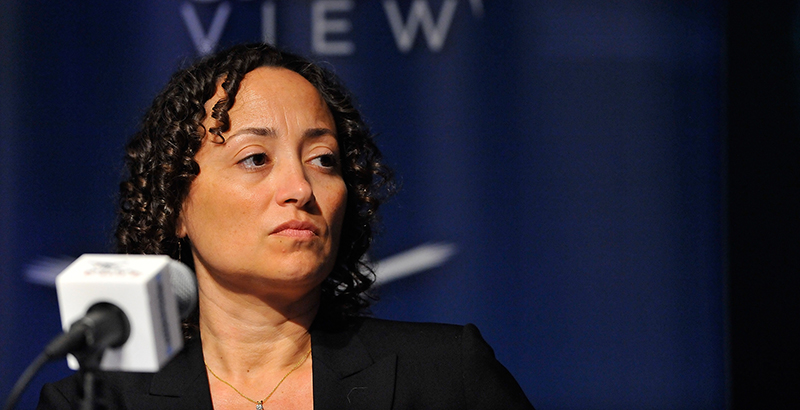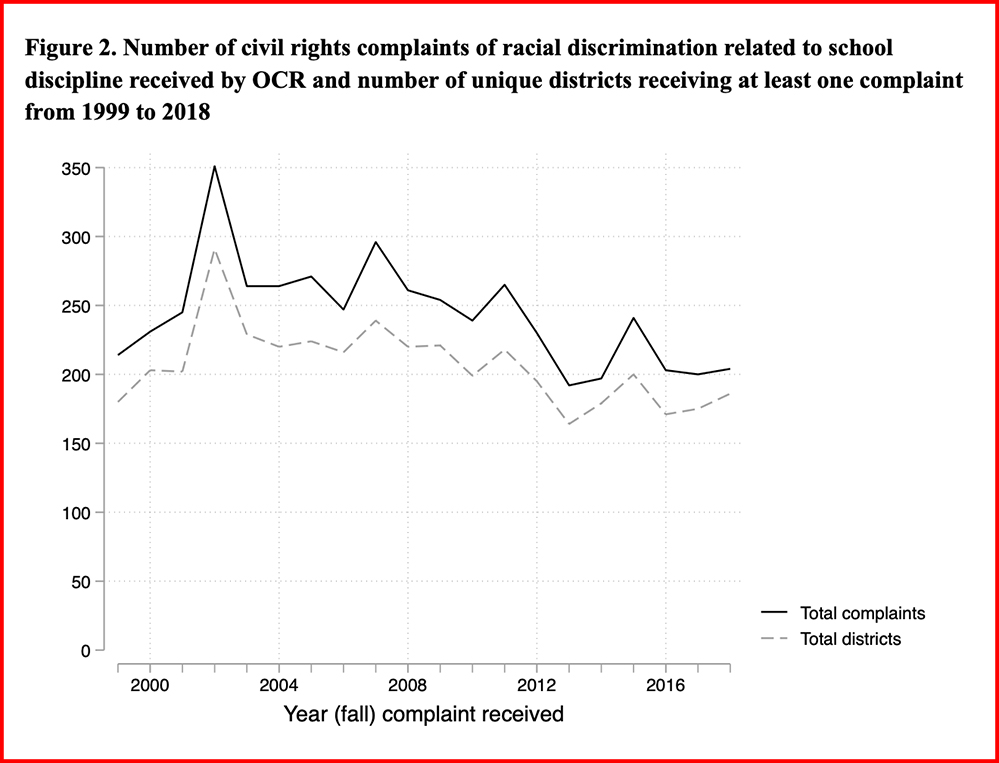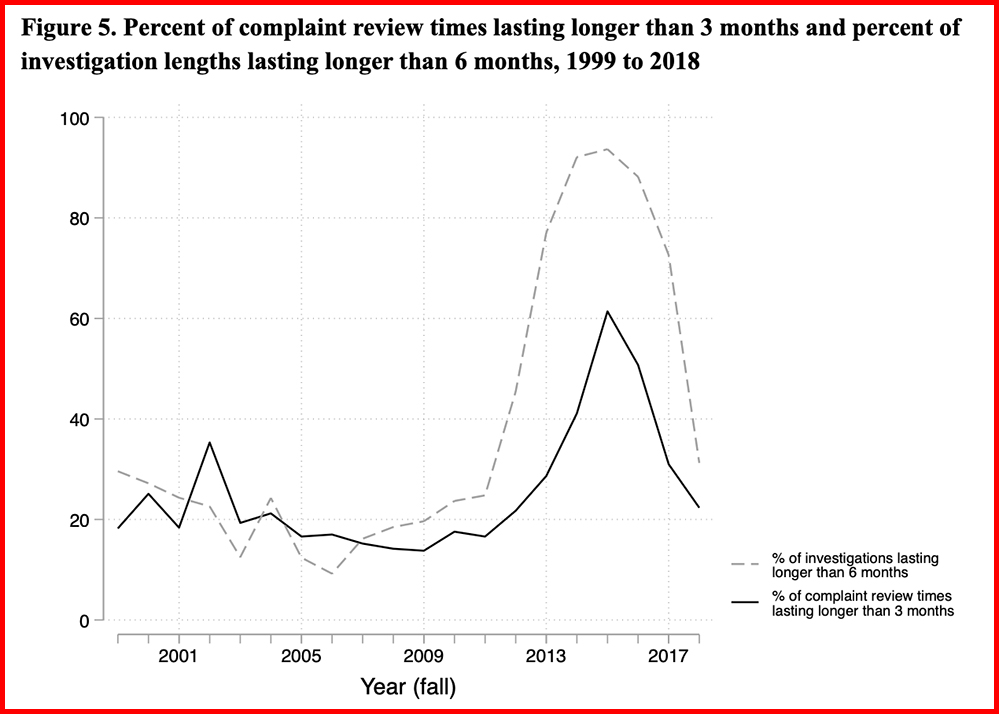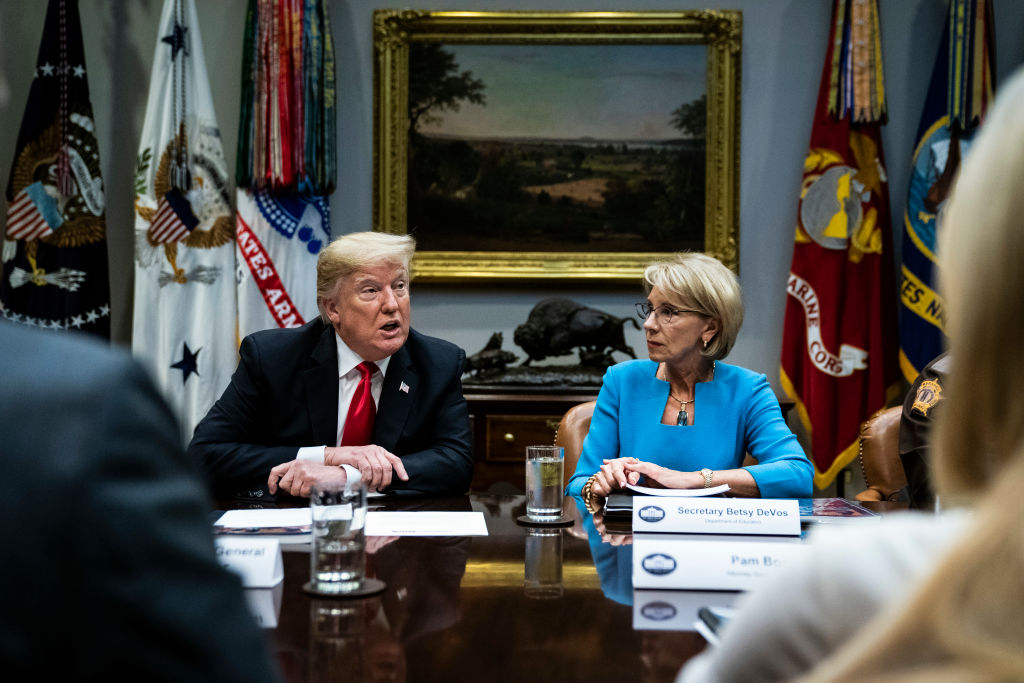A School Discipline Double-Take: How Catherine Lhamon Could Turn Back the Clock With a Renewed Focus on Persistent Racial Disparities — and Ignite New Feuds

Get essential education news and commentary delivered straight to your inbox. Sign up here for The 74’s daily newsletter.
When former President Donald Trump secured the White House, a top priority was clear from the onset: Erase the legacy of foe and predecessor Barack Obama.
A newly sidelined Catherine Lhamon, who led the Education Department’s Office for Civil Rights during the Obama administration, refused to watch quietly. Just months into Trump’s term, a ProPublica investigation found the new administration was quietly scaling back civil rights enforcement and Lhamon, citing “grave concerns,” launched an inquiry of her own.
“I’m deeply worried about the kinds of discrimination that may be allowed to proliferate if there’s not an effective and meaningful civil rights backstop,” Lhamon, who became chair of the U.S. Commission on Civil Rights, told The 74 in 2017. The final Commission report offered a blistering critique of Trump’s civil rights record.
The Trump administration’s sharp turn in direction could be felt at the civil rights office, where Lhamon oversaw sweeping investigations into schools’ student discipline policies and questioned whether they were racially biased. The Trump administration, with just a few strokes of the pen, rolled back much of the Obama administration’s civil rights work in schools, including guidance that sought to combat the nation’s stark and persistent racial disparities in suspensions and expulsions. Trump administration efforts to narrow the focus of investigations, she said, were “dangerous.“
Now it’s Lhamon’s turn to undo Trump’s legacy and restore the priorities of an earlier era. But as she’s poised to return to her old job leading the civil rights office, she is likely to face opposition from both the right, which sees her as a radical and has a newfound zeal for attacking race-based policies in education, and activists on the left, who say the Obama administration didn’t do enough to protect students of color from harsh school discipline, especially at the hands of campus police. Meanwhile, a new RAND Corporation report that takes a sweeping 20-year look at the Office for Civil Rights concluded that its investigations are an insufficient vehicle to deliver justice to students who have suffered discrimination.
President Joe Biden nominated Lhamon last month to once again be the Education Department’s assistant secretary for civil rights; she awaits a confirmation hearing that will almost certainly also drill down on other contentious issues, such as campus sexual assault and transgender student rights, another culture war cause of the GOP. On the discipline front, earlier this month the Education Department announced plans to revisit the issue and explore policy options that promote campus safety through “fair and nondiscriminatory school discipline.” Weeks earlier, 23 state attorneys general wrote a letter to the Biden administration, urging them to reinstate and strengthen the Obama-era guidance, citing “a clear connection between exclusionary school discipline and an increased rate of incarceration.”
Policymakers and pundits have clashed for years over the factors behind racial disparities in discipline and how to remedy them, but Lhamon is expected to resume her work on the issue in a new political environment. George Floyd’s murder at the hands of a Minneapolis police officer last year sparked a national debate over the way students of color, Black children in particular, are disproportionately arrested at school compared to their white classmates, leading districts across the country to sever longstanding ties with the police.

In recent months, the way educators teach students about the historic and present realities of racism has risen to the top of the national discourse as “critical race theory” becomes a partisan landmine. The concept argues that racism isn’t merely a product of individual prejudices but, rather, is baked into government policies.
Russell Skiba, a school psychology professor at Indiana University-Bloomington whose research focuses on inequities in school discipline, said that Lhamon’s tenure represented “a major step in providing leadership to the country” about racial disparities in suspensions, But it’s critical, he said, that the Biden administration expands its focus on the role school-based police play in the disparate treatment of Black students.
“It was extremely important for the Obama administration to step up and essentially validate what researchers had known for a long time and what many, many schools and school districts were beginning to find out, that preventive approaches to discipline are simply more effective,” he said. As civil rights officials investigated the source of racial disparities in school discipline, Skiba said the data was “a canary in a coal mine that says there is still a problem there, our system still has the effects of 400 years of racism and oppression somehow wound into it.”
An Education Department spokesman said that Lhamon declined to comment during her confirmation process. In line with Biden’s executive order on advancing racial equity, the Education Department is “exploring ways that states, schools and communities can help close” racial disparities in school discipline.
“All students deserve access to safe, supportive schools and classrooms,” Education Secretary Miguel Cardona said in a press release. “Discrimination and use of exclusionary discipline can negatively impact students’ abilities to learn, grow and thrive.”
“We ended up with lots of files of increasingly stale documents based on investigations that had begun with good intentions and much fanfare but which led nowhere.” —Kenneth Marcus, Education Department’s assistant secretary for civil rights during the Trump administration
Yet, as the Obama-era Education Department opened expansive civil rights inquiries, cases piled up and investigations took longer to close. Kenneth Marcus, who led the civil rights office during the Trump administration, sought to make investigations more efficient but faced accusations he was overzealous in closing them. During the Obama years, the office was “biting off more than it could chew,” Marcus told The 74, adding that many investigators were frustrated because they lacked “the skills, time or ability in many cases” to carry out the work.
“We ended up with lots of files of increasingly stale documents based on investigations that had begun with good intentions and much fanfare,” he added, “but which led nowhere.”

‘Rethink discipline’
Much of the school discipline debate revolves around a legal concept that one expert called the “cousin” of critical race theory: Disparate impact. The latter occurs when officials deem policies discriminatory if they have a disproportionately negative effect on a racial group but weren’t clearly created with biased intent. The concept was central to the Obama administration’s approach on school discipline.
Under Lhamon’s leadership in 2014, the Departments of Education and Justice released a joint “Dear Colleague” letter that warned districts that their discipline policies could constitute “unlawful discrimination” under federal civil rights law if they didn’t explicitly mention race but had a “disproportionate and unjustified effect on students of a particular race.” While the document acknowledged that racial disparities in student discipline rates may be “caused by a range of factors,” it said that the “substantial racial disparities” couldn’t be attributed entirely to “more frequent or more serious misbehavior by students of color.”
Racial disparities in school discipline are starkest for girls. Black girls are more than four times more likely than white females to face suspension, according to a Georgetown University analysis of the most recent federal data. Meanwhile, Black boys are more than twice as likely to be suspended than their white male classmates. Such disparities exist across other sanctions, including expulsions and school-based arrests.

The Obama guidance document marked a turning point for the civil rights office, which had previously deprioritized discrimination investigations based purely on disparate impact. Meanwhile, the Obama administration instructed federal investigators to broaden the scope of civil rights inquiries, including those related to racial discrimination in school discipline, to assess whether systemic biases were at play.
The efforts were part of a broader effort encouraging school leaders to “rethink discipline” by adopting measures like restorative justice and reducing their reliance on exclusionary practices like suspensions. Though schools across the country embraced alternatives to suspensions and discipline rates dropped, the racial disparities remained.
But even as districts seek to reduce suspensions and focus on alternatives like restorative justice and positive behavioral interventions and supports, a new report in the Review of Educational Research raises serious questions about whether those efforts are sufficient. The report found “limited evidence” that such programs reduce the disparities — and, in fact, end up protecting white and female students in disciplinary situations more than students of color.

Kashish Bastola, a 17-year-old student from McKinney, Texas, said he wasn’t surprised when the state education department flagged his district for racial disparities in discipline last year.
“We’ve seen that in our classrooms, we’ve seen that with my closest friends getting dress-coded just because they’re Black,” said Bastola, an ambassador and organizer with the youth-led group Student Voice. “The way we have our dress code set up, it’s so subjective that teachers and administrators can dress-code you and say you violated a rule based on a broad interpretation of the policy. That, to me, seems really dangerous.”
Though more needs to be done, Bastola lauded the Obama administration’s focus on reducing discipline disparities, which helped shift educators “away from the idea that schools have to be punitive.”
An office under stress
In recent years, a significant body of research has found that suspensions, expulsions and school-based arrests can be detrimental to student learning, including lowered academic performance and an increased likelihood of dropping out.
These negative effects fall disproportionately on the shoulders of Black students, who are less likely than their white classmates to graduate from high school. During the 2017-18 school year, Black students represented 15 percent of the country’s public school enrollment and 38 percent of those who received at least one out-of-school suspension, according to the most recent federal data.
“There’s a hierarchy to how teachers treat students based on these physical characteristics — boy, girl, light-skinned, dark-skinned, immigrant, all of these kinds of things — and some [students] have been very privy to paying attention to that.” —Leton Hall, middle school science teacher, New York City
The root causes of these disparities are complicated and varied, according to a recent report in the peer-reviewed journal Social Forces, which focused on the discipline of elementary school students. But nearly half of the discipline gap could be attributed to teachers treating Black and white students differently, suggesting that the “differences in punishment may be due to racial bias” among educators. The report concluded that just 9 percent of the disparities could be explained by differences in behaviors between Black and white children, a frequent talking point among critics of Lhamon’s position on school discipline.
“In elementary school in particular, when misbehavior tends to be relatively common and relatively minor, educators exercise high levels of discretion in determining sanctions for inappropriate behavior,” according to the report. As a result, some educators’ responses are marred by racial stereotypes.
Leton Hall, a middle school science teacher in the Bronx, has experienced such bias first-hand. During the Trump administration, Hall and other members of the Educators for Excellence advocacy group urged officials to keep the Obama guidance in place.
“I have seen biases, even in myself as a Black man, of how I’ve, at some points, targeted males of color” with discipline more harshly than their peers, he said. As he became more experienced, he grew more lenient toward students, he said, “but I’ve seen other teachers not give kids leeway and automatically go toward the top-of-the-rung of what you need to do to discipline a kid when maybe that wasn’t necessary.”
Students in his school are acutely aware that such disparities exist, he said, and on occasion call them out.
“There’s a hierarchy to how teachers treat students based on these physical characteristics — boy, girl, light-skinned, dark-skinned, immigrant, all of these kinds of things — and some of them have been very privy to paying attention to that,” he said. He said it’s critical that teachers recognize and combat their own biases.

Despite more attention on the issue in recent years, federal civil rights complaints related to racial discrimination in school discipline have remained relatively steady, according to a new, in-depth analysis of federal data spanning two decades. Between 1999 and 2019, families and advocates filed nearly 5,000 racial discrimination complaints related to school discipline, less than half of which led to federal investigations, according to the report, which was conducted by Rachel Perera, a Ph.D. candidate at the Pardee RAND Graduate School.
Nearly every case was settled through voluntary agreements between the Education Department and school districts yet, during the Trump administration, Perera found that a higher share of cases were closed after a finding of no violations or insufficient evidence compared with the final stretch of the Obama administration, when discipline disparities became a major focus.
That finding, Perera said, is “consistent with the concerns that civil-rights advocates have been raising” about the Trump administration’s focus on efficiency. But her research also highlighted a major drawback to Obama’s approach: The time officials took to complete cases “significantly increased” during Lhamon’s tenure followed by dramatic declines during the Trump administration. A spokesperson for the Education Department, whose civil rights office has nearly 600 full-time employees and an annual budget of $130 million, declined to comment on the report.
To Perera, the findings suggest that the office was either under-resourced, a problem Lhamon has also cited, or that federal investigators “are not equipped to do this type of work.” Regardless of the reason, the lengthy investigations were a “big drawback in pursuing this as an avenue for recourse,” because a years-long backlog “doesn’t necessarily help the students and families who are needing some relief” when they file complaints.

Despite that need for relief as the disparities persist, Perera concluded that federal civil rights investigations aren’t “an effective way to narrow disparities at scale.” If the civil rights office “is going to be an avenue for all students, they seem to to be under-resourced to do that.”
‘Common ground’ unlikely
To Marcus, the Trump-era civil-rights chief, Lhamon and other Obama officials were overly focused on pushing schools to address “statistical anomalies” that advanced a political agenda. After Trump’s presidency, he returned to his post as the founder and chairman of the Louis D. Brandeis Center for Human Rights Under Law, a group focused on Jewish civil rights.
While it’s important for investigators to identify discriminatory actions that “do not reveal themselves through explicit language and policies,” he said that disparate impact inquiries are “often used to cut corners in order to put pressure on institutions to address statistical anomalies whether there is bias or not.”
“It is unfortunate that the debate has become politically polarized,” Marcus lamented. “It is also unfortunate that, sometimes, corners are cut so that, instead of ferreting out discrimination, government officials instead try to implement what can look too much like numerical quotas.”
Marcus’s comments mirrored those from attorney and Trump administration advisor Hans Bader, who for years has accused the Obama administration of forcing districts to create “racial quotas” to ensure that students of color are disciplined at similar rates to their white classmates. In an email, he criticized a U.S. Commission on Civil Rights report, released in 2019 under Lhamon’s leadership, which argued that students of color “do not commit more discipline offenses than their white peers” but receive harsher and longer punishments. As such, the report recommended that the Education Department offer districts guidance on “how to comply with federal nondiscrimination laws” when disciplining students. But the report, Bader said, made “unsupported claims about misbehavior rates being the same,” and failed to provide adequate evidence to back up that central thesis. In fact, one dataset on student behaviors highlighted in the report had actually shown the opposite.

In 2018, the school shooting in Parkland, Florida, drew new attention to school violence and school discipline policies, with some Republican lawmakers and pundits claiming that discipline-reduction efforts made schools less safe. A federal school safety commission led by Trump’s Education Secretary Betsy DeVos released a report that argued the Obama-era guidance created “a chilling effect” on teachers’ ability to punish students and “likely had a strong, negative impact on school discipline and safety.” DeVos rescinded the Obama guidance days later.
Michael Petrilli, president of the Thomas B. Fordham Institute, a right-leaning think tank, said the Trump administration’s decision to use Parkland as motivation to rescind the guidance was “really a bad decision because it conflated two issues that really were not closely connected,” but he supported the policy shift nonetheless, pointing to poverty and community crime rates as drivers behind the racial disparities in discipline.
Now, if the Education Department prods districts to reduce their discipline rates as schools recover from the pandemic, it could have unintended consequences. Heightened emotional challenges among students, he worried, could prompt a spike in behavioral problems.
“Kids are going to bring some of that with them into schools, some of that trauma, and some kids are going to act out and they’re going to misbehave,” Petrilli said. “Schools need to be ready to have strategies that are going to keep kids safe and keep the classroom orderly.”

The advocates want more
Though the 2014 guidance letter signified a newfound focus on combating racial disparities in school discipline, Obama-era efforts to reduce suspensions preceded both it and Lhamon’s tenure. In 2012, for example, the Education Department reached a major deal with the Oakland, California, public schools to create alternatives to suspensions and reduce disparities.
Jackie Byers, director of the Oakland-based Black Organizing Project, said the federal agreement was critical because the Oakland district “wasn’t going to address this without a mandate,” but it also came with side effects. Even as suspension rates dropped, she noted that the racial disparities persisted and that educators sometimes gamed the numbers through “off-book suspensions.” Meanwhile, officials’ focus on suspensions and expulsions failed to adequately confront the racial disparities in school-based law enforcement referrals.
After a decade-long battle, the Black Organizing Project won a major victory last year when the Oakland school board voted unanimously to eliminate the district police department, a change that followed Floyd’s murder in Minneapolis.
“I’ve seen models of where it works exceptionally well, where it even provides a pathway for students to look at themselves as potential law enforcement officers.” —Education Secretary Miguel Cardona when asked whether he supports police in schools
Now, as the Biden administration scrutinizes racial disparities in student suspensions, Byers said that federal officials should take a lesson from Oakland. While she’s heartened by the new administration’s “willingness to at least talk about race,” and its “willingness to address racial disparities in pieces of school discipline,” she accused officials of lacking “the courage to address the issue of policing.”
In response to a question from The 74 in May, Cardona, Biden’s new education secretary, called police presence in schools “a positive thing.”
“I’ve seen models of where it works exceptionally well, where it even provides a pathway for students to look at themselves as potential law enforcement officers,” Cardona told reporters at the Education Writers Association’s national seminar. But school-based policing, he continued, must be “done well, or else it could turn really negative.”
For Byers, Cardona’s statement suggests a lack of commitment to racial equity in school discipline, noting “a direct correlation between policing and suspensions.”
“If you are willing to address one part of it, but you’re not willing to address this — and in fact, you’re willing to invest in more policing — then to me you’re not really serious about shifting the culture. You are interested in maintaining at least the status quo.”
Get stories like these delivered straight to your inbox. Sign up for The 74 Newsletter

;)
